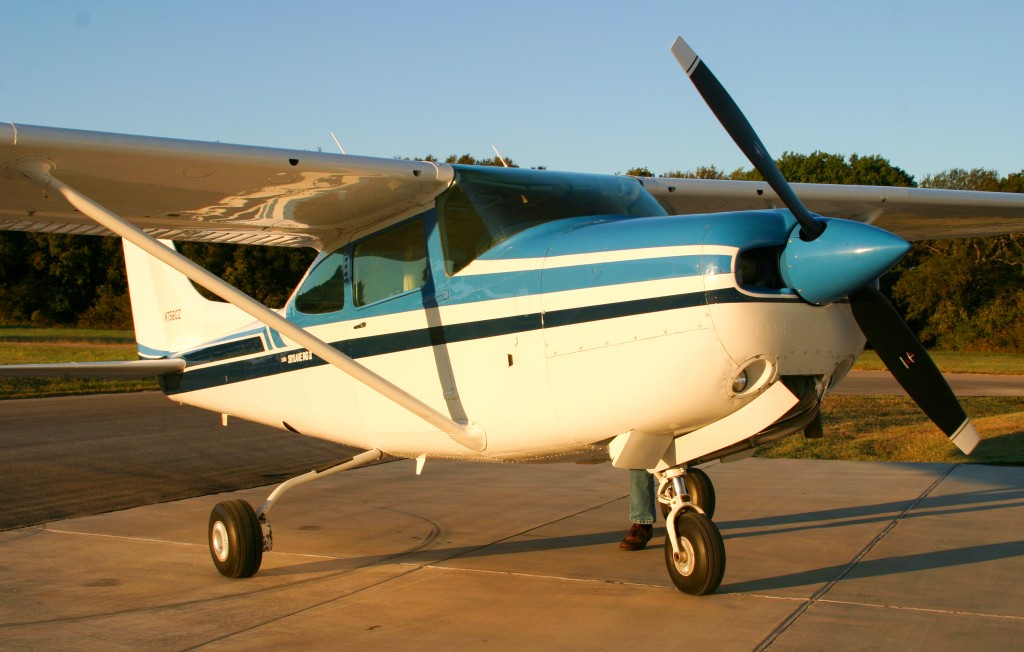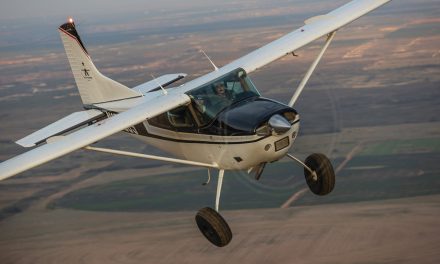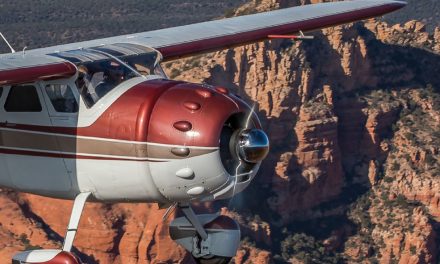Cessna 182RG Specs and Performance Summary
| Cruise speed (knots) | 160 |
| Fuel (gal) | 92/552 |
| Engine | Lycoming IO-540-J3C5D |
| HP | 235 |
| Payload (lbs) | 739 |
| Useful Load (lbs) | 1291 |
| Tell Us How We Can Help | (Click the link of what would help you most) |
| I own one and I need parts | I own one, but am looking to sell. |
| I do NOT own, but am looking to buy. | I was in search of specs and/or performance data. |
| Just curious (other) |

Thirty years after its official demise, pilots still love the Cessna Skylane RG, normally aspirated or turbo.
The Skylane RG was introduced in 1978 to almost unanimous rave reviews from both the aviation press and, more importantly, the flying/buying public. A turbocharged version premiered a year later with essentially the identical engine supplemented by a blower. Turbocharging further expanded the airplane’s utility value and made it a viable model in the high country of the west.
Unfortunately, the timing was all wrong. Skylanes had always been popular airplanes in any configuration, but the market was turning downhill in the early 1980s, and Cessna, Piper, and Beech all scaled back production to meet diminishing demand. I was delivering airplanes to Europe and Africa at the time, and I still remember how much I liked the retractable gear. Retractable gear was the final improvement that made the 182 RG a standout design in those heady days. The 182RG was stable, didn’t object to being flown 25 percent of gross (with a ferry permit, of course), and handled nearly as well as a 182 at normal weights.
Over 200 Skylane RGs and Turbo Skylane RGs were produced before Cessna shut down all piston production in 1986. This gave the retractable Skylanes the dubious distinction of being two of the shortest-lived Cessna models, through no fault of their own. In 1986, the last year of Skylane RG production, a normally aspirated RG sold for $136,680 and a turbo model had an average list of $150,755.
Buy My Sky: The Flights and Times of Bill Cox for more insights from Bill Cox
So, here we are in 2015, and the Skylane RG has been laid to rest for some 30 years. As if we needed an excuse, it seemed a logical idea to look back at the old Skylane RG and consider what preceded it and what followed it. The airplane we found at Channel Islands Aviation in Camarillo, CA, was, in many respects, typical of the type. A 1979 turbo model with only 2700 hours total time and 970 hours on the engine, the airplane was fitted with a standard stack of Cessna radios plus a King DME. The paint was new, but the rest of the airplane was original: a 36-year old, middle-of-the-road family station wagon without a mean bone in its aluminum body.
Perhaps for that very reason, many pilots regard the folding-foot Skylanes as among the best used-plane buys on the market. In addition to simple systems, docile handling, and good load-lifting capability, Skylanes of all types have long enjoyed outstanding resale value.
Inevitably, some readers are bound to ask up front about the relative advantages of the Skylane, Skylane RG, and Turbo Skylane RG, so we fell back on our trusty library of Jane’s All-The-World’s Aircraft for a look at 1979 comparative specs and consulted Aircraft Bluebook Price Digest to examine prices. It’s apparent that the big jump in price comes for retractable gear and that turbocharging was relatively minor delta, both in 1979 and today. It’s also interesting that the normally-aspirated Skylane RG is the strongest climber, despite its heavier weight. Both of the retractables offer better payloads than the higher gross weight. All three airplanes are essentially four-seat, full-fuel machines, always one of the Skylanes’ strongest recommendations.
Aside from the obvious addition of retractable gear, another major change on the Skylane RG was a switch from the carbureted Continental O-470 to a Lycoming O-540 engine, primarily to accommodate the retractable-nosewheel housing. In other applications, the big 540-cubic-inch Lycoming churns out as much as 350 hp (Navajo Chieftain, Mirage), and Cessna considered upgrading horsepower on the RG. In the inevitable domino effect of any design change, more power would have precipitated a higher fuel burn. In turn, that might have necessitated a larger fuel capacity to preserve range, demanding a higher gross weight which could have increased stall speed, possibly requiring aerodynamic changes. The result would have been substantial design and certification expense. As a result, the finished airplane was rated for only 235 hp, a mere 5 hp more than the original Skylane.
Max rpm for both climb and cruise was set a neighborly 2400 rpm, relegating use of the prop control to the ramp. Such severe derating meant the big Lyc was hardly working, and the result was a 2000-hour TBO on both the normally-aspirated and turbocharged RGs.
While the minuscule horsepower increase by itself made no difference in climb or cruise, one might logically have expected the shift from fixed to retractable gear to yield more than 12 knots of speedup. One explanation may be that a standard Skylane would be working hard to generate 144 knots, whereas virtually all the Skylane RGs could score 156 knots. In other words, the real gap between the two models may have been slightly greater than book numbers suggest.
Flying the RG is reminiscent of flying a standard Skylane in almost all respects. It’s true that the numbers on the gauge at cruise are a little higher, but that’s hardly noticeable in the way the airplane handles, especially during takeoff and landing. Liftoffs are a decidedly casual affair with only 235 hp pushing 3100 pounds of airplane. The turbo surge grants the airplane notably more enthusiasm, but you need to monitor the power manually, as the wastegate isn’t automatic. The engine is essentially turbo-normalized rather than turbo-supercharged, with maximum manifold pressure set at 31 inches. This also means any change in manifold pressure, rpm, or mixture dictates changes to all other settings. Similarly, any changes in ram air pressure caused by climb or descent affect higher manifold pressure, and that also demands adjusting prop and mixture.
Gear retraction is a decidedly simple affair, with no significant pitch change and wheels swinging down and then arcing back into the belly wells with the help of 1500 pounds of hydraulic pressure. The sprung steel legs are so slim that there’s very little drag associated with the gear, so there’s minimal aerodynamics effect on gear retraction or extension. We’re certain none of our readers would make this mistake, but it’s important to remember that the gear drops straight down about one foot before retracting. More than one hotdog RG pilot has retracted the feet a little early, letting the wheels slam into the runway, sometimes resulting in a noseover and major prop dings.
Like its big brother, the Cessna 210, the Turbo Skylane RG didn’t use gear doors. Early 210s did employ doors, but the sequencing mechanism was more trouble than it was worth, causing a number of accidents. All later Cessna retractable singles (the Cardinal, Skylane and Cutlass) swing the wheels back into simple wells. Speed loss by eliminating the gear doors was only two knots, and the reduction in headaches with gear doors proved well worth the change.
Once the airplane clears the runway and starts uphill, climb rate settles on an easy 1000 fpm or more if the 182RG is lightly loaded. The standard-breathing Skylane RG suffers a slightly lower service ceiling than the stiff-legged airplane, because of the additional weight of turbocharging. Predictably, the heavy breather does its best work up high and is approved for 75 percent cruise at 20,000 feet. This means that critical altitude (the maximum height at which the engine can produce sea-level power) is about 14,000 feet.
Perhaps the primary advantage of a turbo in day-to-day operation is the preservation of climb, a safety benefit that has more meaning than fast cruise. Accident reports often cite crashes because of a lack of climb rate, but I’ve never heard of an airplane crashing because of slow cruise speed. At 12,000 feet, when the other two 182s are running out of steam, the Turbo Skylane RG can still deliver 800 fpm. That’s a significant safety factor if your flying takes you into high-altitude strips in summer when density altitude can easily climb to five figures.
If you’re like most people who fly behind turbos, you may prefer to operate at non-oxygen altitudes—typically 11,500 or 12,500 feet. At these heights, you can expect about 160 knots true on 14 gph. Any pilot willing to strap on a mask and high jump to the flight levels will find the basic speed advantage is an extra 15 knots of cruise. Those who’ve explored the airspace above 14,500 feet, however, know that there are other benefits to high flight. First, you’ll most often top all the weather rather than having to slog along in the scud down below. Turbulence is minimal at higher altitudes, and terrain clearance most often isn’t even a consideration.
If the airplane does well up high, it does even better down low. Handling in the pattern is simple as long as you keep the trim moving. Inexplicably, stall speed doesn’t increase at the higher weight. It remains a low 50 knots, and that means approaches as slow as 60 to 65 knots aren’t unreasonable. Cessna recommends a 66-knot short-field approach speed, equal to 1.3 Vso, but I’ve used 60 knots many times with power on and never experienced that “verge of destruction” feeling.
Like all the Skylanes that went before it, the Turbo Skylane RG is magnificently mediocre. It doesn’t do anything at the head of the class, but it does so many things acceptably well, it’s hard to ignore. Even if you’re not a big fan of Cessnas, even if you don’t like high-wing airplanes, the Turbo Skylane RG offers so much talent that it just may be one of the best used four-seat retractables on the market.
Complete Cessna 182RG Specs and Performance – Cessna Skylane RGII
All specs and performance numbers are taken from official sources whenever possible. In some cases on older airplanes where there were significant variations between year models of the same airplane, specs may disagree with those from various other sources but will always be within one percent.
| Cruise speed (knots) | 160 |
| Service Ceiling (ft) | 18,000 |
| Stall Spd (knots) | 50 |
| Rate of Climb (fpm) | 1140 |
| Engine | Lycoming IO-540-J3C5D |
| HP | 235 |
| Engine TBO | 2000 |
| Power Ldg (lbs/hp) | 1319 |
| Gross Weight (lbs) | 3100 |
| Empty Weight (lbs) | 1809 |
| Useful Load (lbs) | 1291 |
| Fuel (gal) | 92/552 |
| Payload (lbs) | 739 |
| Wingspan (ft/in) | 35’ 10” |
| Length (ft/in) | 26’ 8” |
| Height (ft/in) | 8’11” |
| TO run (ft) | 820’ |
| TO run over 50 ft | 2125’ |
| Ldg over 50 ft | 1320’ |
| Ldg (ft) | 620’ |
| Cabin width (in) | 43 1/2 |






